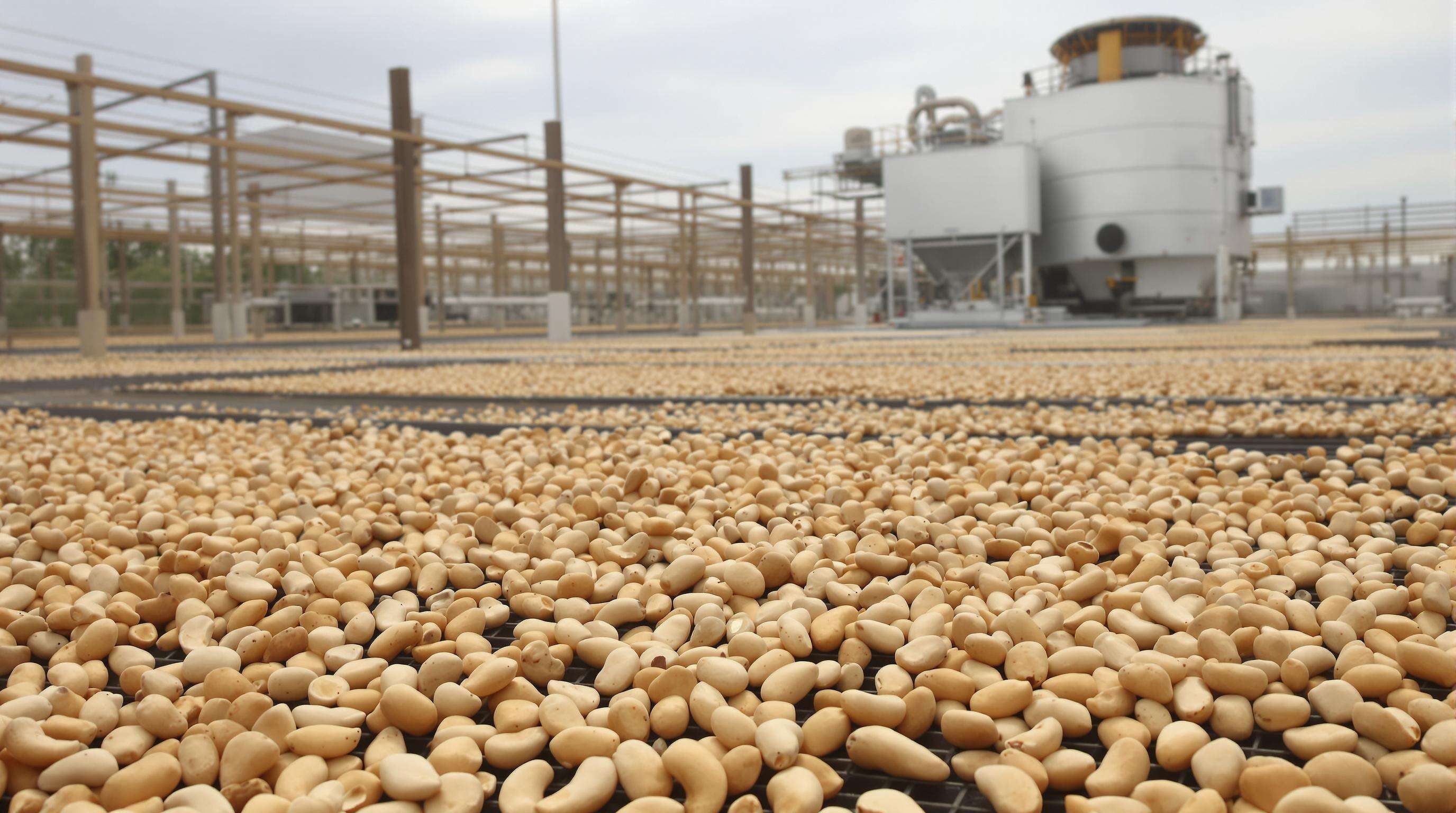Overview of Cashew Processing : From Harvest to Market-Ready Kernels
Key Stages in a Cashew Processing Plant
Cashew processing facilities today convert raw nuts into consumable kernels via around 12 to 15 carefully orchestrated steps. The process kicks off with cleaning out all sorts of dirt and foreign matter before moving on to reduce excess moisture content. Manufacturers roast the cashews at temperatures between 200 and 210 degrees Fahrenheit for approximately 12 to 20 minutes, which effectively removes harmful compounds from the shells. Automated machinery now recovers whole kernels at rates ranging from 85% to 92%, way better than traditional hand methods that only manage about 65% to 75%. At the end of the line comes peeling, thorough sterilization processes, and finally sealing everything in packages flushed with nitrogen gas to satisfy international food safety requirements across different markets.
Why Raw Cashew Nuts Require Specialized Processing
The raw cashew nut contains some pretty nasty stuff inside called cardol and anacardic acids, which are basically skin irritants that need to be neutralized somehow. If they aren't properly treated through methods like industrial steam cooking or oil bath roasting at around 160 to 180 degrees Celsius, these compounds stay active and make the cashew dangerous to eat. A recent report from the Food and Agriculture Organization shows that nearly half of small scale processing operations run into problems with microbes because their drying processes aren't quite right. This points to why controlling both temperature and moisture levels during processing matters so much for food safety across the industry.
The Science Behind Cashew Nut Deactivation and Kernel Preservation
When heat is applied during processing, it actually breaks down those pesky urushiol compounds by changing their protein structure. According to research published in the Journal of Food Chemistry last year, just half an hour of steam roasting can cut down allergic reactions by nearly 94%. Modern facilities have taken things even further with special packaging techniques. They create these modified atmosphere packages where only about 3% oxygen remains alongside 97% nitrogen, then seal everything under vacuum. This combination keeps products fresh for up to 18 whole months without sacrificing much of anything important like the kernel's valuable oleic acid content which stays around 97% intact. And let's not forget about moisture control either. Keeping water content between 4 and 6 percent stops oils from going bad and helps maintain that satisfying crunch consumers love so much.
Drying and Roasting: Preparing Nuts for Shelling

Drying Raw Cashew Nuts to Prevent Spoilage
Drying raw cashews ranks right at the top of priorities when setting up a processing operation. The goal here is to bring down that moisture content from around 16 to 25 percent all the way down to under 9%. If left too wet, these nuts become breeding grounds for fungus and start going rancid fast, which obviously affects both safety and what customers expect in terms of quality. Most folks in the business will tell you that sun drying works best in tropical regions where it takes about two to three days under good conditions. But when consistency matters more than seasonal factors, mechanical dryers come into play for those who need reliable results throughout the year regardless of weather patterns. What makes this process so important? Well, taking things slow during drying helps maintain the natural cell structure inside each nut while reducing the chances of splits forming across the surface. And let's face it, nobody wants their kernels falling apart after all that work.
Sun-Drying vs Mechanical Drying in Tropical Climates
Small-scale processors often use sun-drying due to low capital costs, but this method risks uneven drying during rainy seasons. Mechanical dryers use heated air (40–70°C) to achieve uniform moisture levels in 8–12 hours. Though more energy-intensive, they ensure hygiene compliance and reduce bottlenecks—key advantages for export-oriented facilities.
Roasting Methods: Drum Roasting, Oil Bath, and Steam Cooking Compared
Three primary roasting methods prepare cashews for shelling:
- Drum Roasting: Nuts rotate in heated drums (180–200°C) for 15–20 minutes, producing a smoky flavor favored in traditional markets.
- Oil Bath Roasting: Submerging nuts in heated CNSL or edible oils ensures rapid, even heating but requires degreasing afterward.
- Steam Cooking: High-pressure steam softens shells in 8–12 minutes, minimizing toxic fumes from CNSL combustion. This eco-friendly method is increasingly adopted to comply with emissions regulations.
Balancing Flavor and Safety: Oil Bath vs Steam Roasting
When cashews get roasted in oil baths, they develop that rich buttery taste most people love. But there's usually around 3 to 5 percent oil left behind after roasting, which means an extra step of washing them afterward. Steam cooking offers a different approach altogether. It gets rid of those oil residues completely and cuts down on acrylamide formation by about 40 percent when compared with traditional dry heat methods according to research from IFT in 2023. The downside? Cashews roasted this way often miss out on those nice caramel flavors that make them so appealing in high end snack markets. So manufacturers face a real dilemma here between keeping things safe for consumers and maintaining that desirable taste profile customers have come to expect.
Selecting Roasting Techniques Based on Scale and Market Demand
For smaller operations that handle under 5 tons each day, most tend to stick with drum roasters or oil roasting methods because they get better flavor consistency across batches. The bigger guys processing more than 20 tons a day are moving away from traditional methods though. They're adopting steam systems mainly to satisfy those strict EU and USDA organic standards that keep getting updated every few years. Some smart companies are now experimenting with hybrid approaches too. These setups start with steam treatment then finish off with a quick oil roast. This gives them the best of both worlds really – maintains production efficiency while still meeting food safety regulations and keeping consumers happy with their snack quality expectations.
Shelling and Peeling: Extracting and Refining Cashew Kernels
Manual vs Mechanized Shelling: Labor vs Throughput Trade-offs
When it comes to cashew processing, facilities face a choice between manual and mechanized shelling approaches. The manual approach involves skilled workers using traditional hand tools, which works best when producing premium quality cashews where keeping the kernels intact matters most. But there's a catch - these methods only yield about 6 to 8 kilograms per worker each hour, simply not enough for big operations needing serious volume. On the other side of things, mechanized systems can crank out anywhere from 150 to 200 kilograms per hour, giving massive boosts in production speed though they require substantial upfront costs and regular maintenance. Some plants opt for hybrid solutions too, combining automated cracking machines with final manual extraction steps. This mixed method manages to keep breakage rates below 4 percent while still maintaining decent processing speeds.
High Kernel Breakage in Manual Shelling: Causes and Solutions
Manual shelling typically results in 10–15% breakage due to inconsistent pressure and variable shell hardness caused by CNSL exposure. Solutions include ergonomic tool redesigns, such as angled cracking blades, and steam conditioning to stabilize shells. Training programs focused on hand positioning reduce fatigue-related errors by 28% (India Cashew Development Board 2023).
Hybrid Shelling Models: Combining Precision and Efficiency
Leading facilities now use semi-automated systems where machines crack shells and workers extract kernels. This approach reduces labor costs by 40% while maintaining breakage rates at or below 5%, meeting export-grade quality benchmarks.
Peeling the Testa: Achieving Premium Kernel Appearance
Removing the testa (inner skin) is crucial for market value—fully peeled kernels command a 25% price premium. Advanced plants use dual-stage peeling: hot air at 75°C loosens the skin, followed by soft-bristle abrasion. Optical sensors detect residual fragments with over 95% accuracy, triggering targeted re-peeling when needed.
Moisture Conditioning for Effective Testa Removal
Optimal moisture (12–14%) prevents kernel brittleness during peeling. Steam chambers hydrate nuts uniformly in 8-minute cycles, enabling 98% clean peeling rates. Over-hydration (>16%) increases microbial risk, underscoring the need for real-time humidity monitoring.
Grading, Quality Control, and Packaging for Export

Grading Cashew Kernels by Size, Color, and Defects
Most modern processing facilities rely on a three level grading approach to get the most out of their product. The first step involves vibration sieves that basically shake apart the kernels according to their size range. Whole "W" grade corn measures around 8 to 10 millimeters across, while the smaller "S" pieces fall below that threshold. Next comes color sorting where machines pick out those prized ivory white kernels that have minimal blemishes (less than 5% discoloration counts as acceptable). These premium grains go into higher end markets. The final stage tackles defects like broken bits, burnt remnants, and anything damaged by pests. Top notch operations can hit almost 99% purity rates when following the latest USDA export standards from 2023. This kind of meticulous sorting makes all the difference in meeting international quality expectations.
Meeting International Standards: AA-Grade and Moisture Requirements
Export-grade cashews must maintain moisture below 5% (Codex Alimentarius 2023) to prevent fungal growth. AA-grade requirements include:
- At least 95% whole pieces
- No more than 2% broken bits
- Zero detectable aflatoxins
Automated moisture analyzers reduce non-compliance by 63% compared to manual sampling, according to recent industry analysis.
AI-Powered Optical Sorting in Modern Cashew Processing Plants
| Sorting Method | Accuracy | Throughput | Defect Detection |
|---|---|---|---|
| Human Labor | 82% | 50 kg/hr | Visible flaws only |
| AI Vision | 99.7% | 400 kg/hr | Subsurface defects |
| Neural networks trained on 2 million kernel images now detect internal voids and subtle defects missed by traditional inspection. |
Packaging Methods to Preserve Freshness: Vacuum Sealing and MAP
Modified Atmosphere Packaging (MAP) with nitrogen flushing extends shelf life to 18 months by reducing oxygen to less than 1%. Vacuum-sealed foil pouches dominate premium exports, preserving crunchiness 37% longer than paperboard packaging (Journal of Food Engineering 2023).
Eco-Friendly Packaging Innovations in Sustainable Cashew Processing
Leading manufacturers are adopting compostable cassava starch bags that decompose within 90 days. These innovations reduce plastic waste by 18 metric tons annually per mid-sized facility while meeting ISO 22000 food safety standards.
Frequently Asked Questions (FAQ)
Why do raw cashew nuts need specialized processing?
Raw cashew nuts contain skin irritants like cardol and anacardic acids, which must be neutralized during processing to ensure they are safe for consumption.
What are the primary methods for roasting cashews?
Cashews are roasted using drum roasting, oil bath roasting, or steam cooking. Each method has its advantages in terms of flavor and safety.
How are cashew kernels graded and sorted?
Cashew kernels are graded by size, color, and defects using vibrational sieves, color sorting machines, and defect detection methods to meet international quality standards.
What packaging methods ensure cashew freshness for export?
Modified Atmosphere Packaging (MAP) with nitrogen flushing and vacuum sealing in foil pouches extend the freshness and shelf life of cashews for up to 18 months.
What innovations are available in sustainable cashew packaging?
Sustainable cashew packaging includes compostable cassava starch bags that reduce plastic waste and decompose quickly, aligning with ISO 22000 food safety standards.
Table of Contents
- Overview of Cashew Processing : From Harvest to Market-Ready Kernels
- Drying and Roasting: Preparing Nuts for Shelling
- Shelling and Peeling: Extracting and Refining Cashew Kernels
-
Grading, Quality Control, and Packaging for Export
- Grading Cashew Kernels by Size, Color, and Defects
- Meeting International Standards: AA-Grade and Moisture Requirements
- AI-Powered Optical Sorting in Modern Cashew Processing Plants
- Packaging Methods to Preserve Freshness: Vacuum Sealing and MAP
- Eco-Friendly Packaging Innovations in Sustainable Cashew Processing
- Frequently Asked Questions (FAQ)

